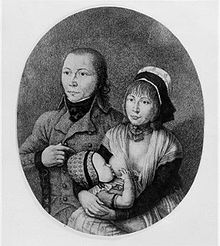

Johannes Bückler (c. 1778 – 21 November 1803; German pronunciation: [joˈhanəs ˈbʏklɐ]) was a German outlaw who orchestrated one of the most famous crime sprees in German history. He has been nicknamed Schinderhannes and Schinnerhannes (pronounced [ˈʃɪn(d)ɐˌhanəs]) in German and John the Scorcher,[1] John the Flayer[2] and the Robber of the Rhine[3] in English. He was born at Miehlen, the son of Johann and Anna Maria Bückler. He began an apprenticeship to a tanner but turned to petty theft. At 16 he was arrested for stealing some of the skins, but he escaped detention. He then turned to break-ins and armed robbery on both sides of the Rhine, which was the border between France and the Holy Roman Empire.
The legend of Schinderhannes truly emerged from his escape from a prison tower in Simmern, a market town in the Hunsrück region of the Rhineland. At the time, the west bank of the Rhine was under French occupation, and the peasantry was happy to celebrate anyone who was able to flout the law. At the end of 1798, Bückler had a criminal record that included thefts of at least 40 head of cattle and horses. He was arrested by French gendarmerie and brought before a judge, where he confessed some of his crimes. Imprisoned in a wooden tower in Simmern that most believed to be impenetrable, he used a kitchen knife, smuggled in by a sympathetic guard, and cut a hole in a small window to escape. The prison escape became widely reported, exciting the public and making Schinderhannes a folk hero.
The legend of Schinderhannes grew with every new escapade. After things began to get too dangerous for him, Schinderhannes fled across the Rhine and enlisted in the Austrian Army under the assumed name of Jakob Schweikart. He was recognized, however, by a former associate, handed over to the French authorities and imprisoned in a tower of the medieval defensive wall of Mainz (the so-called "Holzturm"). After his mistress, Juliana Blasius, was threatened with being charged as an accomplice, Schinderhannes testified against his fellow gangsters. Nineteen of his associates were sentenced to death. Despite his cooperation, Schinderhannes was sentenced to death as well. On 21 November 1803 he was guillotined before the gates of Mainz. More than 40,000 spectators witnessed his execution. He remains Germany's most famous outlaw. His legend still attracts a great deal of tourism to the region wherein his gang operated.
- ^ Chambers 1879, p. 509.
- ^ Hugo 1845, p. 279.
- ^ Ritchie 1833.